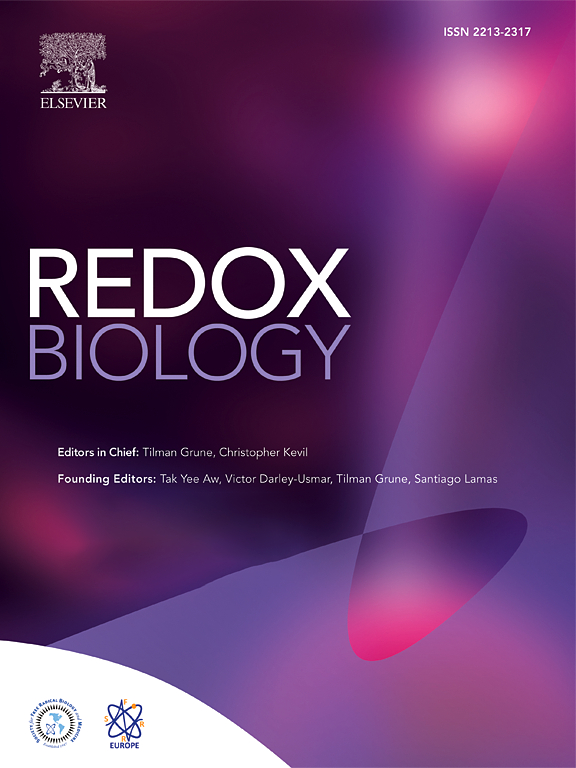活性氧产量低的中性粒细胞会在免疫启动过程中被激活,并促进关节炎的发展。
IF 10.7
1区 生物学
Q1 BIOCHEMISTRY & MOLECULAR BIOLOGY
引用次数: 0
摘要
类风湿性关节炎(RA)是一种由免疫细胞功能障碍介导的炎症性自身免疫疾病,目前尚无普遍有效的预防和治疗策略。作为主要效应细胞,中性粒细胞在类风湿关节炎发病过程中对关节炎症攻击起着重要作用。在这里,我们利用单细胞测序技术彻底分析了骨髓来源的中性粒细胞在II型胶原蛋白(COL2)诱导的关节炎(CIA)模型中的表型特征,包括用COL2诱导和增强的小鼠。我们发现了一个中性粒细胞亚群,该亚群中性粒细胞胞质因子 1(NCF1)在诱导小鼠中高表达,并伴有特征性的活性氧(ROS)反应,而在增强小鼠中,随着关节炎的发病,Ncf1的表达量减少。此外,我们还发现,ROS 减少后,原始小鼠会出现关节炎,但增强小鼠的关节炎则会减轻。ROS 的这种双向作用表明,ROS 在免疫激活过程中起着保护作用。从机理上讲,我们将功能测定与代谢组学相结合,发现Ncf1缺陷的中性粒细胞的迁移、趋化受体CXCR2表达、炎性细胞因子分泌和Th1/Th17分化均有所增强。这种改变主要是由于Ncf1缺陷型中性粒细胞的代谢重新编程,从以葡萄糖生成为主的能量供应途径转变为与组氨酸、甘氨酸、丝氨酸和苏氨酸信号代谢相关的炎症免疫途径,进而诱发关节炎。总之,我们系统地发现了ROS调控下中性粒细胞的功能和炎症表型特征,为理解RA的发病机制提供了理论依据,有助于进一步改进预防策略和发现新的治疗靶点。本文章由计算机程序翻译,如有差异,请以英文原文为准。
Neutrophils with low production of reactive oxygen species are activated during immune priming and promote development of arthritis
Rheumatoid arthritis (RA) is an inflammatory autoimmune disease mediated by immune cell dysfunction for which there is no universally effective prevention and treatment strategy. As primary effector cells, neutrophils are important in the inflammatory joint attack during the development of RA. Here, we used single-cell sequencing technology to thoroughly analyze the phenotypic characteristics of bone marrow-derived neutrophils in type II collagen (COL2)-induced arthritis (CIA) models, including mice primed and boosted with COL2. We identified a subpopulation of neutrophils with high expression of neutrophil cytoplasmic factor 1 (NCF1) in primed mice, accompanied by a characteristic reactive oxygen species (ROS) response, and a decrease in Ncf1 expression in boosted mice with the onset of arthritis. Furthermore, we found that after ROS reduction, arthritis occurred in primed mice but was attenuated in boosted mice. This bidirectional effect of ROS suggested a protective role of ROS during immune priming. Mechanistically, we combined functional assays and metabolomics identifying Ncf1-deficient neutrophils with enhanced migration, chemotactic receptor CXCR2 expression, inflammatory cytokine secretion, and Th1/Th17 differentiation. This alteration was mainly due to the metabolic reprogramming of Ncf1-deficient neutrophils from an energy supply pathway dominated by gluconeogenesis to an inflammatory immune pathway associated with the metabolism of histidine, glycine, serine, and threonine signaling, which in turn induced arthritis. In conclusion, we have systematically identified the functional and inflammatory phenotypic characteristics of neutrophils under ROS regulation, which provides a theoretical basis for understanding the pathogenesis of RA, to further improve prevention strategies and identify novel therapeutic targets.
求助全文
通过发布文献求助,成功后即可免费获取论文全文。
去求助
来源期刊

Redox Biology
BIOCHEMISTRY & MOLECULAR BIOLOGY-
CiteScore
19.90
自引率
3.50%
发文量
318
审稿时长
25 days
期刊介绍:
Redox Biology is the official journal of the Society for Redox Biology and Medicine and the Society for Free Radical Research-Europe. It is also affiliated with the International Society for Free Radical Research (SFRRI). This journal serves as a platform for publishing pioneering research, innovative methods, and comprehensive review articles in the field of redox biology, encompassing both health and disease.
Redox Biology welcomes various forms of contributions, including research articles (short or full communications), methods, mini-reviews, and commentaries. Through its diverse range of published content, Redox Biology aims to foster advancements and insights in the understanding of redox biology and its implications.
 求助内容:
求助内容: 应助结果提醒方式:
应助结果提醒方式:


